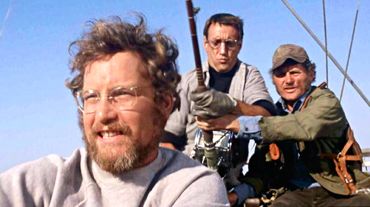 Reports surface now and then that the original “Jaws” is being remade. A modern production, perhaps even directed by Steven Spielberg, would take advantage of the huge advances in film special effects since the mid-1970s.
Reports surface now and then that the original “Jaws” is being remade. A modern production, perhaps even directed by Steven Spielberg, would take advantage of the huge advances in film special effects since the mid-1970s.
But computer graphics would ruin the fun, the director says on Universal Home Entertainment’s Blu-ray edition of “Jaws.”
Back in 1974, the endlessly problematic mechanical sharks of “Jaws” couldn’t be used for most of the filming — a “blessing in disguise,” Spielberg says today.
Not being able to show the shark tearing the flesh from the skinny-dipping girl meant viewers had to imagine what was being done to her, just under the dark surface. The human imagination being the most powerful special effect of them all.
Fortunately, Spielberg did participate in a major restoration of the 1975 film, a five-month project done in conjunction with Universal’s 100th anniversary.
The resulting version of “Jaws” that debuts on Blu-ray looks and sounds better than the film that ran in cinemas in 1975, he says.
The source negative was in “pretty crummy” shape, Spielberg says in the Blu-ray’s nine-minute short about the restoration.
“Jaws” does look terrific, if a bit too polished. Scratches, blotches, speckling, excess grain — all gone. As with many cinematic works of its era, the look and feel of “Jaws” bring to mind a well-made telefilm — without some of the filmic qualities of a traditional Hollywood movie.
 The new 7.1 audio delivers the thrills with authority — the menace of John Williams’ thumping shark theme amplified by the watery-grave subwoofer lows. Despite the seven-speaker format, the “Jaws” surround mix is on the conservative side, perhaps a recognition that audiences of 1975 were good and creeped out without hyperactive separation.
The new 7.1 audio delivers the thrills with authority — the menace of John Williams’ thumping shark theme amplified by the watery-grave subwoofer lows. Despite the seven-speaker format, the “Jaws” surround mix is on the conservative side, perhaps a recognition that audiences of 1975 were good and creeped out without hyperactive separation.
Spielberg, as usual, provides no feature-length commentary. But the director has plenty to say in two full-length (and then some) documentaries:
“The Shark Is Still Working: The Impact and Legacy of Jaws” (2007) is new to Universal’s “Jaws” tackle box, appearing only on the new Blu-ray. Roy Scheider (Chief Brody) narrates and, of course, also appears as himself in the documentary.
The “Shark” documentary opens with an advisory that it was made by and for “Jaws” fans. Fair warning. The nearly 2-hour running time will test the patience of viewers who haven’t made it to a “Jaws” convention just yet. The filmmakers even used the handle Finatic Productions.
As fan salutes go, “Shark” is top of the line. The filmmakers had access to many of the key people who worked on “Jaws,” including Spielberg. That makes sense because these “fans” also work in the movie industry.
“Shark” has little bite, as you’d expect: “It’s hard to imagine a world in which Steven Spielberg is not a household name,” the script tells us in one of the film’s many descents into hyperbole. (Scheider does what he can with the watery script.) Directors Kevin Smith, Eric Roth and M. Night Shyamalan turn up to state the obvious and waste viewers’ time.
 In what has to be some kind of first, a chapter looks at the making of the “The Making of Steven Spielberg’s Jaws.”
In what has to be some kind of first, a chapter looks at the making of the “The Making of Steven Spielberg’s Jaws.”
That’s Laurent Bouzereau’s fine documentary, which dates back to the 1995 laserdisc and is included here at its full length. The seminal making-of film launched Bouzereau’s triple-threat career as a making-of specialist, currently with more than 300 titles to his credit. If you’re a fan of DVD extras, you’ve seen Bouzereau’s work.
Both docus give the hard-luck shoot of “Jaws” a full review, focusing on myriad problems with the mechanical sharks. Spielberg recalls “Jaws” as a “fun movie to watch, but not a fun movie to make.”
Actor Scheider says of the seven-month shoot on Martha’s Vineyard: “We thought we’d be there the rest of our lives.”
The movie was one of the first major productions to shoot all of its ocean footage in the ocean. Spielberg says the battered cast and crew came away with deep respect for the natural forces at work in the ocean, such as waves and tides.
Of the pre-CGI production challenges, producer David Brown says, “Had we read (the book) twice … there was no way we would have made (the movie). He describes it as a “guerrilla” production, in which plans for some scenes were concealed from the studio suits.
“Jaws” was a best-selling novel before it was a film. Few remember these days, but some vocal fans of Peter Benchley’s book weren’t pleased that it had been sanitized for Hollywood. Lost was the major subplot in which the oceanographer has a messy affair with the police chief’s wife. Benchley, who saw his original plot shredded, dispels any notion of bad blood in the water over those changes.
Of the “Jaws” phenomenon, Benchley says, “No one had an idea of what we had, including me.”
Spielberg says he thought the movie might do well in cities by the water.
Richard Dreyfuss and Scheider vie for camera time, spinning terrific stories. Dreyfuss has the “Jaws” rap down to performance art, acting out how the film crew was bombarded with radio messages that “hisssscratch … the shark is not working.” Dreyfuss covers the same ground in both “Jaws” documentaries.
For the record: Scheider insists he never referred to the mechanical shark as Bruce, and never will. Spielberg named the killing machine after his lawyer. The docu points out that “Jaws” contributed to a greater understanding of predatory sharks such as the great whites over the decades, helping with their conservation. Probably didn’t do much for the sport of diving in shark cages, though, as the docu includes chilling footage of a great white destroying a cage (some of that footage appears in the movie).
The “Shark” docu does a close-up on actor Robert Shaw , who apparently thought Dreyfuss quite the putz. Shaw, a writer, came up with the idea of having his character tell the tale of the sinking of the WWII-era USS Indianapolis. The grisly details of many of its sailors’ deaths by sharks were declassified just before the making of “Jaws,” the docu says. Some family members learned of their loved one’s fate by watching “Jaws.”
“From the Set” is a 9-minute British TV piece hailing from 1974. The 26-year-old Spielberg, hot off “The Sugarland Express,” is interviewed in the waters off Martha’s Vineyard. He looks like a pop star but talks like a savvy pro. (“Young, courageous and stupid,” he later calls himself.) The high concept was “Duel” at sea. (“Duel” was Spielberg’s 1971 telefilm.)
Universal’s “Jaws” Blu-ray also includes 14 minutes of deleted scenes and outtakes (some interesting; most not), storyboards, still photos, as well as the original trailer that was MIA on the 30th anniversary DVD.
Check out Glenn Abel on Google+



Solid review, Glenn. I think John Milius usually gets credited with Robert Shaw’s monologue about the USS Indianapolis. John did a lot of rewriting and odd writing jobs for his Movie Brat pals in those days.